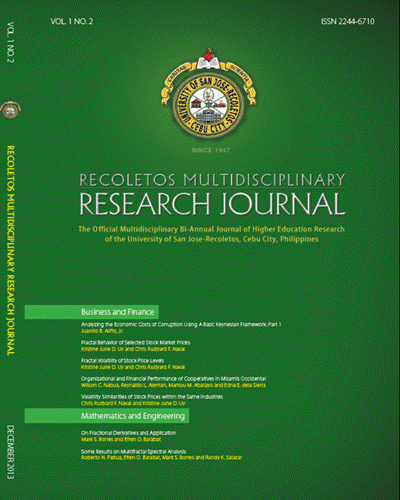An Empirical Validation of the Psychological Anatomy of Gossip
DOI:
https://doi.org/10.32871/rmrj1301.02.08Keywords:
self-concept, anxiety, gossip, communicationAbstract
This study validates the theory on the psychological anatomy of gossip. A person’s inclination to gossip is tested and validated in relation to one’s self-concept and anxiety level. Utilizing researcher-developed questionnaires and employing regression analysis, this paper tested the relationship between a person’s self- concept and anxieties with one’s propensity to gossip. The results of this study supported our three hypotheses: (1) that a person’s self-concept is inversely related to one’s anxieties, (2) that a person’s self-concept is inversely related to one’s propensity to gossip, and (3) a person’s anxiety is directly related to one’s tendency to gossip.
References
Foster, E. K. (2004). Research on gossip: Taxonomy, methods, and future directions. Review of General Psychology, 8, 78-99.
Horney, Karen.(1945) Our inner conflicts. New York: W.W. Norton & Co.
Leary, M. R., & Baumeister, R. F. (2000). The nature and function of self-esteem: Sociometer theory. In M.P. Zanna (Ed.), Advances in experimental social psychology (Vol. 32, pp. 1-62). San Diego, CA:
Academic Press.
Leary, M. R., & Downs, D. L. (1995). “Interpersonal functions of the self-esteem motive.†In M. H. Kernis (Ed), Efficacy, Agency and Self-Esteem (pp. 123-144). New York: Plenum Press.
Michelson, G., and Mouly, S. (2004) ‘Do loose lips sink ships? the meaning, antecedents and consequences of rumour and gossip in organisations’, Corporate Communications: An International Journal, 9(3): 189-201.
Nicholson, N. (1998, How hardwired is human behavior? Harvard Business Review, 76, 134-147.
Rogers, Carl. (1959). A Theory of Therapy, Personality and Interpersonal Relationships as Developed in the Client-centered Framework. In (ed.) S.
Koch, Psychology: A Study of a Science. Vol. 3: Formulations of the Person and the Social Context. New York: McGraw Hill.
Rosnow, R. L., & Fine, G. A. (1976). Rumor and gossip: The social psychology of hearsay. New York: Elsevier.
Wood, J. V., Giordana-Beech, M., Taylor, K. L., Michela, J. L., & Gaus, V. (1994). Strategies of social comparison among people with low self-esteem: Self-protection and self-enhancement. Journal of Personality and Social Psychology, 67(4), 713–731.
Yerkovich, S. (1977).Gossip as a way of speaking. Journal
of Communication, 26, 192–196.
Downloads
Published
How to Cite
Issue
Section
License
Copyright of the Journal belongs to the University of San Jose-Recoletos


